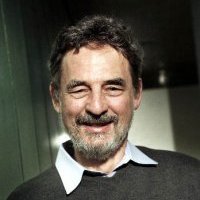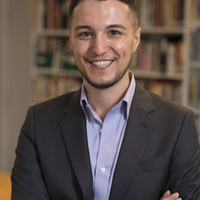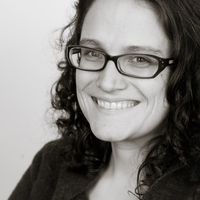Papers by John Mollenkopf
Many observers have noted that immigrants to the United States are highly concentrated in the lar... more Many observers have noted that immigrants to the United States are highly concentrated in the lar est metropolitan areas of a relatively few states. Though immigrants diffused into many places that had previous-ly seen relatively few immigrants during the 1990s, as of the 2000 cen-sus, 77 percent of the nation’s 3 1.1 million foreign born residents still

Introduction Part 1: The Social and Economic Context of Urban Politics A Top 10 List of Things to... more Introduction Part 1: The Social and Economic Context of Urban Politics A Top 10 List of Things to Know About American Cities Elvin K. Wyly, Norman J. Glickman, and Michael L. Lahr. Poverty, Social Rights, and the Politics of Place in the United States Margaret Weir. Overview and Economic Restructuring as Class and Spatial Polarization Saskia Sassen. Social Polarisation, Economic Restructuring and Welfare State Regimes Chris R. Hamnett Part 2: The Roots of Urban Politics Tammany Hall and the Democracy Richard Croker. The Ward Organizations Milton Rakove. Why Political Machines have not Withered Away and Other Revisionist Thoughts Raymond E. Wolfinger. Writing the Rules to Win the Game: The Middle-Class Regimes of Municipal Reformers Amy Bridges and Richard Kronick. Resistance from Outside: Machine Politics and the (Non) Incorporation of Immigrants Michael Jones-Correa Part 3: Understanding Urban Power How to Study Urban Political Power John H. Mollenkopf. Who Governs? Robert A. Dahl....

City in Sight
It is always fascinating to read highly intelligent researchers applying apparently familiar conc... more It is always fascinating to read highly intelligent researchers applying apparently familiar conceptual tools to apparently similar problems, but in a different national context. The urban scholars of the Netherlands whose essays are gathered in this volume reflect thoughtfully on immigrant integration, inter-group relations, neighborhood trajectories, local and national urban development programs, and the nature of contemporary urban citizenship. Their work is informed not only by their own vigorous research tradition, but also by a shrewd and sometimes critical reading of the literature in the US. Reflecting on these essays has been rewarding on at least three counts. Where the problems and conceptual tools really are more or less the same, these essays have heightened my understanding of the issues that face policy makers in both settings and suggested new ways for scholars in the US to research them. The essays on immigrants, inter-group relations, and immigrant integration programs probably offer the most direct comparisons. Where the problems or conceptual tools turn out, on closer inspection, not to be so similar, the distinctive aspects of the situations in the Netherlands are still revealing because they show how urban realities are not restricted by the boundaries implicit in North American approaches. In other words, while these concepts work well for us, they may fail to capture important aspects of similar processes going on elsewhere. This kind of discordance is more evident in the essays on ethnic residential concentration and segregation, mixed income housing, and public efforts to 'improve' neighborhoods. Finally, these situations also reveal how the 'borrowing' of concepts developed in the US national setting can be ill-fitting when applied to the case of the Netherlands, and perhaps Europe, even when the 'borrowers' think the terms fit well. Use of ideas like 'the dual city', 'concentrated poverty', and 'segregation' tend to display this trait. Comparing the Orange and the Apple So how similar are the urban situations of the Netherlands and the US? This question really makes no sense, because it compares a 16.5

The culmination of a year-long lecture series cosponsored by The Century Foundation and the City ... more The culmination of a year-long lecture series cosponsored by The Century Foundation and the City University of New York Graduate Center's Center for Urban Research, 'Rethinking the Urban Agenda' takes up the challenge provided by a changing of the guard in New York City government-the election of a new mayor and city council-to outline a new conceptual and political road map for New York City's future and, in many important respects, for the future of urban America. Contributors include Gordon Berlin (Manpower Demonstration Research Corporation), Alan Brinkley, J. Phillip Thompson, and Lawrence D. Brown (Columbia University), Angelo Falcon (Puerto Rican Legal Defense and Education Fund), Norman Fruchter and Amy Ellen Schwartz (New York University), Nathan Glazer (Harvard University), Michael Jacobson, (John Jay College), Gregory Mantsios (Queens College), James Parrott (Fiscal Policy Institute), Martha E. Stark (Baruch College), and Doug Turetsky (United Neighborhood...
Economic and Policy Review, 2005
This article was presented at a conference organized by the Federal Reserve Bank of New York in A... more This article was presented at a conference organized by the Federal Reserve Bank of New York in April 2005, "Urban Dynamics in New York City." The goal of the conference was threefold: to examine the historical transformations of the engine-of-growth industries in New York and distill the main determinants of the city's historical dominance as well as the challenges to its continued success; to study the nature and evolution of immigration flows into New York; and to analyze recent trends in a range of socioeconomic outcomes, both for the general population and recent immigrants more specifically.

The Urban Book Series
The New York metropolitan area is one of the oldest, largest, and perhaps most complex urban regi... more The New York metropolitan area is one of the oldest, largest, and perhaps most complex urban region in the United States (U.S.). Its 23.7 million residents live across four states, produce a GDP of more than $1.7 trillion, are governed by a fragmented political system, and experience persistently high degrees of geographic and racial/ethnic inequality and segregation. This chapter investigates the evolving spatial organization of occupation and race across the metropolitan area. While white professionals have traditionally lived in an outer ring of suburbs and blue-collar immigrant and minority groups have lived closer to the city center, our research shows that the forces of gentrification and minority and immigrant suburbanization have been turning the metropolitan area inside out. Specifically, young, usually white, professionals are increasingly located in and around the central city whereas many working-class minorities have shifted away from it. At the heart of this spatial re...
Page 1. The Second Generation in New York City: A Demographic Overview by Mary C. Waters, Departm... more Page 1. The Second Generation in New York City: A Demographic Overview by Mary C. Waters, Department of Sociology, Harvard University John Mollenkopf, Department of Political Science, CUNY Graduate Center Philip ...

Institute of Urban Regional Development, Jun 10, 2008
While the economies and populations of the two cities are roughly comparable, their political cul... more While the economies and populations of the two cities are roughly comparable, their political cultures and structures are quite different. Los Angeles is the quintessential "fragmented" and suburbanized metropolis. The City of Los Angeles is but one of 88 municipalities within the County of Los Angeles, which provides a wide range of social and other services that the City does not. (There is, of course, some overlap in functions between the two levels of government, but the City generally provides property-related services, including police, fire, zoning, and planning, while the County provides health and welfare services. Water and power are provided by a semi-independent authority heavily influenced by the city government, while the public schools at present also remain independent, at least until Mayor Antonio Villaraigosa, negotiates with the state legislature to take significant control over the system.) Los Angeles city politics is formally non-partisan. It has relatively few city council members-15 for a population of almost 4 million people-who are elected for staggered four year terms. Since most candidates for city office are Democrats, the Democratic party, which is at best weakly organized at the county level, does not play a major role in deciding the outcomes of the non-partisan primaries for elected office. In any case, no significant party organization operates at the city level. Many city agencies are overseen by commissions whose members are appointed for relatively lengthy terms, thus buffering direct mayoral control. A new city charter in 1999 began to erode some of that independence, giving mayors the authority to unilaterally remove most city commissioners (Sonenshein 2004). LA's city budget for the year ending in 2006 was just under $6 billion, or about $1,500 per resident. (Other levels of government, such as the LA Water and Power, the Harbor, or the LA Unified School District, not to mention LA County government, also spend comparable amounts of money. When the proprietary departments are included, the city budget doubles.) New York, on the other hand, is highly centralized and politicized, with a persistent "machine politics" style. New York City government covers five counties, whose top political officials, borough presidents, have only residual and largely symbolic powers. It has a strong mayor who exercises virtually untempered authority over a wide range of services. The current mayor, Michael Bloomberg, won authority to appoint the Chancellor of the New York City school system. Virtually all governmental functions, save the mass transit system, the port authority, and the City University, are under his or her purview. The City Council is relatively numerous, with 51 members, or about 70 percent more council members per capita than Los Angeles. All elections are partisan, Democratic nominees win almost all elections for city office except for the mayoralty, and regular party organizations exercise a considerable degree over the outcome of the party primaries, sometimes by using arcane election regulations to knock challengers off the ballot. The city budget for the fiscal year ending in 2006 was $54 billion, or roughly $6,750 per resident, almost five times larger than the LA city budget. The two cities therefore provide a theoretically alluring setting for comparison-one can "control" at least in rough terms for economic and demographic structure and examine the impact of varied political structure on the desired outcomes. This has led scholars to create a small post-industrial cottage industry of studies comparing the politics of the two cities (
... Crime Patterns: Frontiers of Practice, P 87-104, 2000, Victor Goldsmith, Philip G. McGuire, J... more ... Crime Patterns: Frontiers of Practice, P 87-104, 2000, Victor Goldsmith, Philip G. McGuire, John H. Mollenkopf, and Timothy A. Ross, eds. ... Abstract: An SDE is a graphic representation of the co-point variation of observations about major and minor axes in two-dimensional space ...
... We are blessed to live with such understanding people. They are (for Jennifer Hochschild) Ton... more ... We are blessed to live with such understanding people. They are (for Jennifer Hochschild) Tony Broh, Eleanor Broh, and Raphael Broh and (for John Mollenkopf) Kathleen Gerson and Emily Mollenkopf. JLH and JHM Page 13. PART I FRAMEWORKS Page 14. Page 15. ...
The City in the Twenty-First Century The Robert F. Wagner, Sr. Institute of Urban Public Policy T... more The City in the Twenty-First Century The Robert F. Wagner, Sr. Institute of Urban Public Policy The Graduate School and University Center of the City University of New York The Robert F. Wagner, Sr. Institute of Urban Public Policy supports the development of volumes on the ...

Institute of Urban Regional Development, Apr 30, 2008
Like other old blue collar cities of the Northeast and Midwest, New York City and its surrounding... more Like other old blue collar cities of the Northeast and Midwest, New York City and its surrounding metropolitan area have faced some serious headwinds from deindustrialization, disinvestment, racial succession, white flight, social and cultural conflict, and many other adverse force. Like many other old industrial cities, New York went through a turbulent period of economic and social decline from the late 1960s through the early 1980s. In New York City's case, this involved a public sector fiscal crisis and high levels of residential property abandonment and arson as well as a more generalized decline of population and employment. Yet unlike the many other once-proud cities that have had to adjust to a lesser status over time, New York has rebounded markedly from its low point in the mid-1970s. Today, it is hard to believe that broad swaths of the New York City terrain had essentially no market value only thirty years ago. Instead, "luxury loft buildings" are rising next to the Brooklyn Queens Expressway and a high priced luxury hotel has been built next to the Gowanus Canal, erstwhile scene of dead bodies and raw sewage overflows during heavy rains. W hat accounts for this dramatic turn-around? How and why did New York City prove to be so resilient, when its 19 century rivals along the East Coast, Philadelphia and Baltimore, have continued to th lose population steadily, as have Cleveland, Detroit, Milwaukee, and St. Louis, and even Chicago? This paper considers some provisional answers to that question. After reviewing the city's development trajectory over the last century and a half, and those of its peers more recently, it outlines the developmental challenges facing New York, appraises some alternative explanations for this outcome, and reflects on which seem most promising. While a full and robust explanation of New York's resilience must await a systematic comparative analysis, which this essay does not attempt, it does highlight some slightly counterintuitive ways of thinking about the problem.
Ethnic and Racial Studies, 2014
International Journal of Health Services, 1979
Marxist analysts have developed theoretical propositions concerning the conflicting functions of ... more Marxist analysts have developed theoretical propositions concerning the conflicting functions of government in advanced capitalist countries, while public policy analysts have examined the logic of public resource allocation. Through an historical analysis of a typical urban bureaucracy, the San Francisco Municipal Railway, this paper describes how bureaucratic structure and functioning relate to broader conflicts over whom government actions should benefit. It concludes that the apparent shortcomings of the organization can be traced to, and were caused by, this conflict. The argument thus draws from each of these two quite different approaches to the question of what logic motivates the public sector.
Espace géographique, 2000








Uploads
Papers by John Mollenkopf